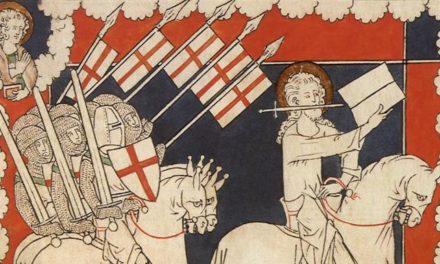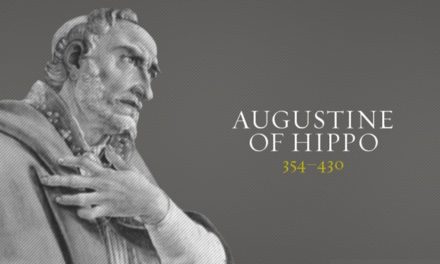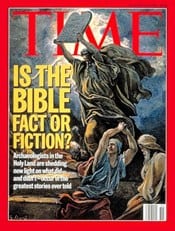This episode is titled, “The Spreading Tree “
Tertullian, pastor of the church of Carthage in North Africa, addressed unbelievers at the beginning of the 3rd C, saying à
“We are but of yesterday, and yet we already fill your cities, islands, camps, your palace, senate and forum; we have left to you only your temples.”
That introduces our theme for this episode; the expansion of the Faith in the early centuries.
Writing in the middle of the 2nd C, Justin Martyr said,
“There is no people, Greek or barbarian, or of any other race, by whatsoever appellation or manners they may be distinguished, however ignorant of arts or agriculture, whether they dwell in tents or wander about in covered wagons—among whom prayers and thanksgivings are not offered in the name of the crucified Jesus to the Father and Creator of all things.”
Comments by other Early Church leaders like Irenæus, Arnobius, & Origen lead us to conclude that by the end of the 3rd C the name of Christ was known, revered, & persecuted in many provinces & cities of the Roman Empire. In one of his edicts, the Emperor Maximian says that “almost all” had abandoned the worship of the old gods for the new sect called Christianity.
In the absence of hard numbers, tallying the number of Jesus’ followers can’t be precise, but a reasonable assumption of the faithful stands about 10 to 12% of the total population at the beginning of the 4th C. In some places, the number was much higher as local movements saw the Gospel take firmer root. According to Chrysostom, the Christian population of the city of Antioch at the end of the 4th C. was half the whole.
While 10% of the entire Empire may not seem that impressive a number, keep in mind that 10% shared a spiritual unity that made them appear a far larger group when set over against the highly-fragmented 90% of the pagan world.
Looking back to Asia where the whole thing started, the Apostles had spread the new faith over Israel, Syria, & Asia Minor. According to Pliny the Younger, at the dawn of just the 2nd C, the pagan temples in Asia Minor were almost completely neglected & animal sacrifices hardly performed because so many pagan had converted to the new faith.
In a first step of what would prove to be a major outreach to the East, during the 2nd C Christianity took root in the city of Edessa in Mesopotamia along with several regions in Persia. In the 3rd C., it reached North into Armenia & South into Arabia.
There’s an enduring legend that the apostles Thomas & Bartholomew carried the Gospel to India. For sure, a Christian teacher named Pantaeus of Alexandria went there about 190. By the 4th C, vibrant national churches were growing in the subcontinent.
It was the moving of the seat of power from Rome to Constantinople in the early 4th C that helped ensure the migration of the Faith eastward. It also meant that all the important early Church Councils were held in or around Constantinople. The great doctrinal controversies over the Trinity & Nature of Christ were carried out mostly in Asia Minor, Syria, & Egypt.
Speaking of Egypt, Christianity in Africa gained a firm foothold first there, during the time of the Apostles. The city of Alexandria was a world center of learning & culture. It’s libraries & schools drew from all over the world and many Jews called it home. It was in Alexandria that the Hebrew Bible was translated into Greek, 200 yrs before Jesus. This Greek Bible, called the Septuagint, opened the seemingly opaque ideas of the Jews to Gentiles seekers after truth for the first time. It was in Alexandria that the religion of Moses was set alongside the philosophy of Plato and Aristotle. It was there the Jewish philosopher Philo sought to harmonize Greek & Jewish thought. Many of his ideas were picked up by later Christian apologists in defending the faith against Roman misconceptions.
Ancient tradition says it was Mark who laid the foundation of the church in Alexandria, which became one of the 5 most important & influential churches of the first Centuries. A theological school flourished in Alexandria from the 2nd C in which the great church fathers Clement & Origen taught. From Alexandria, the Gospel spread South into Nubia (modern Sudan) & Ethiopia. At a council of Alexandria in 235, 20 African bishops attended from all over the Nile basin.
During the 4th C, in a subject we’ll treat more fully in a later episode, Egypt coughed up the Arian heresy, then quickly answered it with Athanasian orthodoxy. Egypt was the birthplace of monasticism as practiced by its earliest advocates, Antony & Pachomius. Monasticism then spread across the rest of the Christian world. But that’s yet another subject for a couple later episodes.
Christianity spread from Egypt across the rest of North Africa quickly. It helped that there were numerous Roman outposts reached by 3 or 4 days sailing from Italy. The faith spread rapidly over the fertile fields & burning sands of Mauritania & Numidia, taking root in Carthage. In 258 a synod of 87 bishops met there & just 50 yrs later the Donatists held a council of 270 bishops.
It may be of interest to some listeners that the oldest Latin translation of the Bible, called the “Itala” & was the basis of Jerome’s “Vulgate”, was produced in Africa for Africans, not in Rome for Romans, because the Christians there used Greek. Latin theology also wasn’t born in Rome, but in Carthage. Tertullian was its father. Latin theology then grew in North Africa to find its zenith in the world of Augustine of Hippo, another North African city. The influence of Augustine simply cannot be overstated, as we’ll see.
After reaching Egypt, Nubia, Ethiopia, and a narrow band of North Africa, the Expansion of the Faith stalled. Whether or not it would have renewed its reach further South becomes moot in light of the Conquest of Islam in the 7th & 8th Cs.
Tracking the expansion of the Faith into Europe, we pick up the report of the early church historian Eusebius who said by the middle of the 3rd C the Church at Rome had a bishop, 46 elders, 7 deacons with 7 assistants, 42 acolytes which we can think of as “interns,” 50 readers, exorcists, & ushers; & 1500 widows & poor who were under its care. From these numbers we guesstimate the actual membership of the Church at about 50,000 or 1/20th of the City’s population. The strength of Christianity in Rome is confirmed by the enormous extent of the catacombs where Christians were buried.
From Rome, the church spread to all the cities of Italy. The first Roman synod we know of was held in the mid-2nd C and had 12 bishops in attendance. A century later there were 60.
An official persecution of the followers of Christ in Gaul in 177 shows the church had to already be there and large enough as to raise the concern of the authorities. The faith arrived in Gaul, not from Rome, but from Asia Minor. We know that because Irenæus, the bishop of Lyons, was a disciple of Polycarp of Smyrna & Irenaeus reported in to his peers in Asia Minor rather than to Rome. It wasn’t till the middle of the 3rd C that Rome sent missionaries to Gaul. One of them was Dionysius who founded the first church at Paris, then died a martyr at Montmartre to become the patron saint of France.
Spain was most likely reached with the Faith in the 2nd C. The Council of Elvira in 306 saw 19 bishops assemble to catch up and discuss the work of their various provinces. The apostle Paul once formed the plan of a missionary journey to Spain, and according to Clement of Rome he did preach there.
Irenæus reported that the Gospel had been preached to the Germans and several other Northern tribes but he likely meant just those portions of Northern Europe that had been brought under Roman control.
Although it’s a bit of a mystery why the North African Tertullian would know, he said the Faith had taken root in Britain by the end of the 2nd C. As we’ll see in a later episode, the Celtic church existed in England, Ireland, & Scotland, quite independent of Rome, long before the conversion of the Anglo-Saxons by the Roman missionary Augustine. In fact, that early Celtic church sent missionaries to Germany, France, & the Low Countries well before the Italian outreach. In the mid-8th C, the Venerable Bede reported that about the year 167 the British king Lucius asked the bishop of Rome to send missionaries. Then, at the Council of Arles in 314, British bishops from York, London & Colchester, were in attendance.
This would be a good place to talk about the Expansion of the Faith into the East but that’s a huge, important, and all too often overlooked part of the History of the Church, so we’ll save it for later. Suffice it for now – as many students of history know, the Roman Empire got stalled in the East, first by the Parthians, then later by their successors, the Sassanids.
The Sassanids gladly applied the principle that the enemy of my enemy is my friend. And that meant from the late 2nd thru 3rd C, as Christians were being persecuted in the Roman Empire, they were welcomed to the East by the Sassanids. The church sprang up and grew rapidly all over Mesopotamia & Persia in what today we know as Iran. Some of the greatest cultural achievements of the Faith during the 3rd C were in this Persian church. But when Constantine embraced Christianity and the Church moved into the position of political favor in the Roman west, you may guess what that meant for the Church in the regions controlled by the Sassanids. Still, this eastern church had developed its own unique culture, and instead of moving back west to join the church of the Byzantine-Roman world, persecution pushed it even further east, all the way to China.
Let’s finish out this episode with a look at Justin Martyr who we began with a quote from.
Justin was born in the ancient city of Shechem in the very center of Israel. But by the time he was born in AD 100, it was a Roman city called Flavia Neapolis = New Flavianberg. Raised by pagan parents, he sought life’s meaning in the major philosophies of his day. But his pursuit of truth resulted in nothing more than a series of bitter disappointments.
Justin was too sharp to swallow the shallow reasoning & logical inconsistencies of pagan thought. Whether it was religion or philosophy, his keen intellect cut through the silliness that was the hallmark of the pagan worldview.
His first teacher was a Stoic who “knew nothing of God and did not even think knowledge of him to be necessary.” After that Justin followed an itinerant philosopher, who was more interested in collecting his fee than the pursuit of truth. Next up was a Pythagorean, but his course in music, astronomy, and geometry was too slow for Justin’s voracious mind. Finally, he applied himself to Platonism which was more intellectually demanding, but proved once again to hold too many inconsistencies.
Then, at about the age of 30, after a long conversation with an elderly gentleman, Justin’s life was transformed. He said, “A fire was suddenly kindled in my soul. I fell in love with the prophets and these men who had loved Christ; I reflected on all their words and found that this philosophy alone was true and profitable. That is how and why I became a philosopher. And I wish that everyone felt the same way that I do.”
Justin was determined to reconcile faith & reason. His work took him first to Ephesus in AD 132 where he held a debate with a Jew named Trypho about the correct way to interpret Scripture. The book which came out of this debate is aptly titled, The Dialogue with Trypho & teaches 3 main points:
1) The Old Covenant has passed away to make place for the New;
2) The Logos is the God of the Old Testament; AND à
3) Believers in Christ constitute a New Israel; that is, the new covenant people of God.
Justin then moved to Rome, founded a school, and wrote 2 bold Apologias = formal defenses of the Faith, intended to be read by pagan officials persecuting Christians. Think of an Apologia like a legal brief.
Justin’s First Apology published in 155 was addressed to Emperor Antoninus Pius. It was an attempt to explain the Faith, which as we saw in an earlier episode was so badly misunderstood by unbelieves of that time. Justin showed how Christianity was not a threat to the State and should be treated as a legal religion.
He reasoned with the Emperor that Christians are his “best helpers and allies in securing good order, convinced as we are that no wicked man … can be hidden from God, and that everyone goes to eternal punishment or salvation in accordance with the character of his actions.” He made an eloquent case for why Christianity was superior to paganism, that Christ fulfilled prophecy, and that paganism was in reality a poor imitation of true religion.
Justin’s First Apology has become an important record for students of history in that he gave a detailed description of early Christian worship to prove to unbelievers the Faith wasn’t some kind of subversive movement. The most famous passage is this:
On the day called Sunday there is a gathering together in the same place of all who live in a given city or rural district. The memoirs of the apostles or the writings of the prophets are read, as long as time permits. Then when the reader ceases, the president in a discourse admonishes and urges the imitation of these good things. Next we all rise together and send up prayers.
When we cease from our prayer, bread is presented and wine and water. The president in the same manner sends up prayers and thanksgivings, according to his ability, and the people sing out their assent, saying the ‘Amen.’ A distribution and participation of the elements for which thanks have been given is made to each person, and to those who are not present they are sent by the deacons.
Those who have means and are willing, each according to his own choice, gives what he wills, and what is collected is deposited with the president. He provides for the orphans and widows, those who are in need on account of sickness or some other cause, those who are in bonds, strangers who are sojourning, and in a word he becomes the protector of all who are in need.
Justin’s Second Apology was written soon after Marcus Aurelius became emperor in 161. In these writings, Justin showed that the Christian faith alone as genuinely rational. He said the Logos; which was an important philosophical concept of the time, became incarnate to teach humanity truth and to redeem people from spiritual deception. Since Marcus Aurelius was a true philosopher Emperor, Justin sought to appeal to his love of truth with this Second Apology.
But the Emperor was more enamored of Greek thought than the new-fangled innovations of the Christians. 4 yrs after penning the Second Apology, Justin and his disciples were arrested. The prefect asked him to denounce his faith by making a sacrifice to the gods. Justin replied, “No one who is rightly minded turns from true belief to false.” It was an easy answer for Justin because he’d spent his adult life discerning the true from the false.
He was taken out and beheaded. Since he gave his life for “true philosophy,” Justin was surnamed Martyr.






love the song at the end. Thank you for the podcast
Monika, It’s 10,000 Reasons by Matt Redman